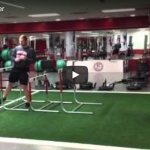I had the privilege of attending the Athletic Performance Summit Featuring the Legends of Strength and Conditioning back in May. It was a seminar that I heard about only a few weeks before. When I saw the lineup of speakers, I knew I had to attend. What really attracted me to this seminar was that most of the presenters worked in the team environment successfully for several years and have the championship rings to prove it.
While the format of the seminar was outstanding, it wasn’t necessarily the information that these guys shared on their power points that made it worthwhile. It was more of their ability to share experiences with the teams and individual athletes that they coached with the attendees. This is something that I find extremely valuable.
These men opened up about their philosophies and programs and were accessible throughout the weekend. For example, Johnny Parker, who was the Strength and Conditioning Coach for the Giants, Patriots, Buccaneers, and 49ers, gave out his phone number and email address to everyone. Talk about a humble human being.
What I also found refreshing was that these guys were truly there to teach, share ideas, and learn. Their passion for what they do really showed. These are coaches who I aspire to be like someday.
These coaches clearly have learned and helped each other with their coaching philosophies as their messages were very similar. For example, Charlie Francis was referenced by all of them numerous times. Tempo running was a staple for a few of them. Also, the Javorek bar complex was also a common theme from an evaluation perspective.
Here are some takeaways that I thought were great quotes or something that I can use now with my athletes:
Al Vermeil
Need to create impulse- explosive power
Never take an athlete to maximum
Adapt to what the athlete can do
Clyde Emerich- “Its not about you, its about them”
Have some speed development drills in your program all the time
Best test- “Can they play?”
Al Miller
Get players best at the start of the season
All players are novice lifters. Takes 10 years to develop an athlete
2400 yards maximum for Tempos in a given workout
600 yards maximum for sprints
Johnny Parker
Cleans and squats should occupy the greatest % of your program
Work on all qualities all of the time
Don’t be afraid to lead
Real players want to be pushed
Don’t let the star mentality affect your program
Rob Panariello
In Season- need intensity, need to have unaccustomed stress
Butt wink- spiderman stretch and hamstring stretch
Eliminate the shift in squatting
Don Chu
Skills:
Start Speed- Jumps in place, standing jumps, multiple jumps, depth jumps
Acceleration- Multiple jumps, box drills, bounding
Change of Direction- Standing jumps, multiple jumps, box drills, depth jumps
Vertical Jump- Jumps in place, standing jumps, multiple jumps, box drills, depth jumps
Horizontal Jump- Standing jumps, multiple jumps, box drills, bounding
Derek Hansen
Elite sprinter- 35% high intensity work, 65% low intensity work
Hamstring injuries are brain injuries- software problem, not hardware problem
Rehab- start short and progress to long
Always finish training with low intensity cyclical activity

